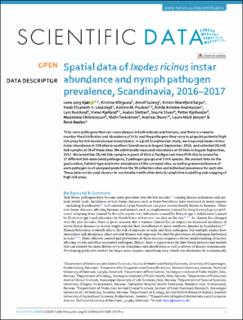Spatial data of Ixodes ricinus instar abundance and nymph pathogen prevalence, Scandinavia, 2016–2017
Kjær, Lene Jung; Klitgaard, Kristine; Soleng, Arnulf; Edgar, Kristin Skarsfjord; Lindstedt, Heidi Elisabeth Heggen; Paulsen, Katrine Mørk; Andreassen, Åshild Kristine; Korslund, Lars; Kjelland, Vivian; Slettan, Audun; Stuen, Snorre; Kjellander, Petter; Christensson, Madeleine; Teräväinen, Malin; Baum, Andreas; Jensen, Laura Mark; Bødker, Rene
Peer reviewed, Journal article
Published version
Permanent lenke
https://hdl.handle.net/11250/2827822Utgivelsesdato
2020Metadata
Vis full innførselSamlinger
Originalversjon
10.1038/s41597-020-00579-ySammendrag
Ticks carry pathogens that can cause disease in both animals and humans, and there is a need to monitor the distribution and abundance of ticks and the pathogens they carry to pinpoint potential high risk areas for tick-borne disease transmission. In a joint Scandinavian study, we measured Ixodes ricinus instar abundance at 159 sites in southern Scandinavia in August-September, 2016, and collected 29,440 tick nymphs at 50 of these sites. We additionally measured abundance at 30 sites in August-September, 2017. We tested the 29,440 tick nymphs in pools of 10 in a Fluidigm real-time PCR chip to screen for 17 different tick-associated pathogens, 2 pathogen groups and 3 tick species. We present data on the geolocation, habitat type and instar abundance of the surveyed sites, as well as presence/absence of each pathogen in all analysed pools from the 50 collection sites and individual prevalence for each site. These data can be used alone or in combination with other data for predictive modelling and mapping of high-risk areas.
